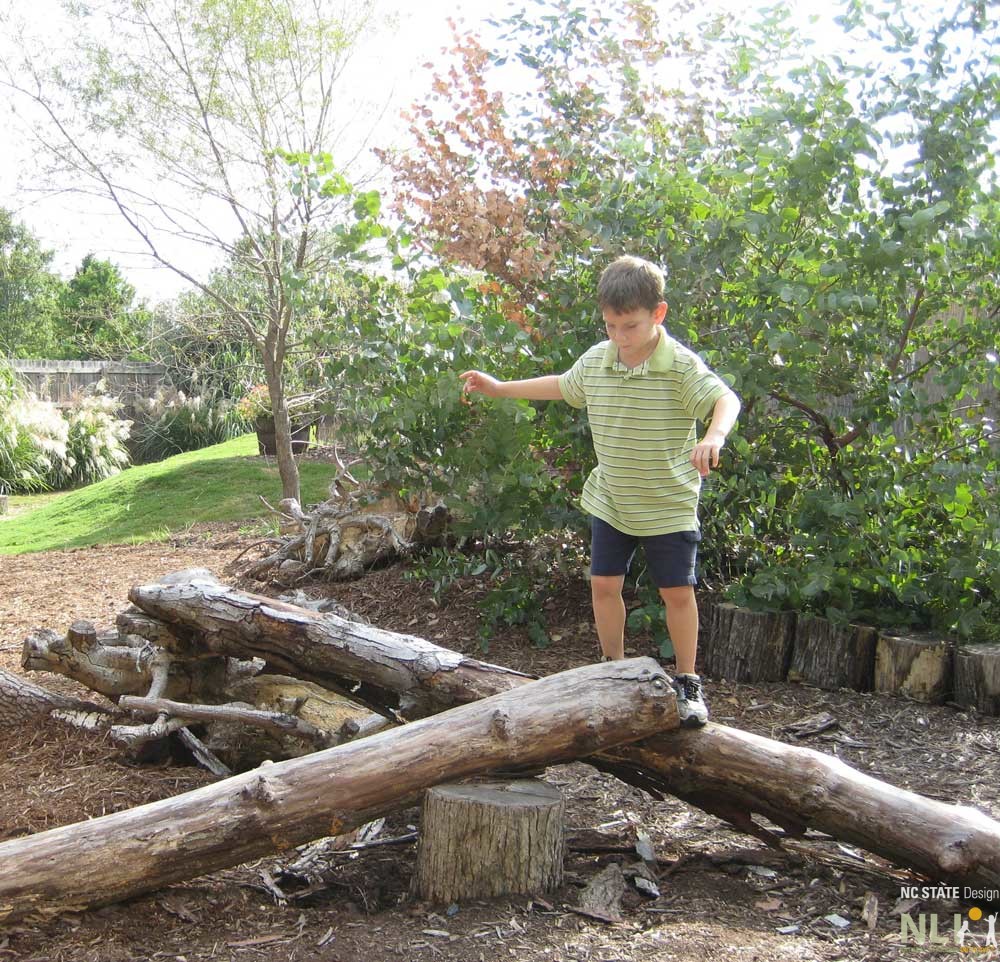The Green Desk
Child Care OLE Regulation FAQ in North Carolina
What do the experts say about safety, risk, and regulation in North Carolina child care environments?
The Natural Learning Initiative has worked together with several different regulating agencies and organizations in North Carolina to get answers to some of the most frequently asked questions about safety, risk, and regulations in child care outdoor environments. The following text and the associated question and answers were written and compiled by the North Carolina Outdoor Learning Environments Alliance. The answers to the questions were written by representatives of the respective agencies and organizations named at the beginning of each answer. While only directly applicable to child care centers in North Carolina, the NLI recognizes the value of these positions on certain hot topics, and hopes their insight can provide some helpful guidance even for centers who do not happen to be subject to the North Carolina regulations.

Play Outside! by the North Carolina Outdoor Learning Environments Alliance
Child care providers have many questions about what they can, and can’t do, on and in their outdoor area. They have concerns that there may be violations or demerits from the licensing consultant, the environmental health specialist or from an environment rating scale assessor if they are having an assessment done for a rated license. In an attempt to dispel some of the concerns that are floating around, listed below are some of the most frequently asked questions about outdoor learning environments. We are all committed to removing barriers to staff taking children outdoors, while still ensuring that the experiences that the children have are healthy, safe and enriching.
As new questions are received they will be added to this list. We hope that you find them helpful as you work to enhance your outdoor area for the children in your care. This resource is in development and is not yet complete, but it does hold valuable information that can be used as it is completed. The questions and issues included in this handout have been given attention from the North Carolina Rated License Assessment Project, the Division of Child Development, and Children’s Environmental Health Branch with position statements (in development) from the NC Outdoor Learning Environments Alliance.
Further Resources
Inclusion of Natural Elements in the Play Yard
- Are large stones and/or rocks considered tripping hazards inside the fenced area? We are thinking of using them as borders to create a garden space or perhaps as part of our outdoor learning environment activities and décor.
- Do you have to have mulch around 12-18 inch high stumps for ECERS? If it is ok with licensing, is it ok with the ECERS assessment folks? If yes, then how much mulch or what depth is needed?
- Would stumps in general on the playground be considered a health and safety issue due to splinters? What will the ECERS folks say?
- Can we have stumps on our playground with lichens or small mushrooms growing on them? Our playground has children between the age of 2.5 years and six years that play on it?
Learning about Birds, Bugs, and other Critters
- If we put up bird feeders, what type is acceptable? Humming bird feeders are probably not the issue; however, we are wondering about other bird feeders as the seeds may drop on the ground and/or droppings from the birds.
- If we have a bird bath, how often does the water need to be changed or the bath cleaned?
- Is it ok to dig for bugs or use a “carpet lift up” or plastic bath mat to attract and watch bugs?
- Rule .2831 was amended effective August 2, 2007 and includes a prohibition against keeping amphibians as pets. Does this preclude keeping tadpoles at child care as an educational project for children to observe the development of tadpoles into frogs?
Digging in the Dirt
- Is it really ok to have a dirt pile for the children to dig in on your playground? If so is a cover needed? (One suggestion is to have a large round “swimming pool tub” to put the dirt in, or a type of sand table that can be covered. However, can a dirt area be created that has borders with a cover similar to a sand pit play area?)
- If we do have dirt for children to dig in, what type of dirt should it be….dirt from the earth or should we buy topsoil/dirt from a nursery?
Seating & Spaces Outdoors to Observe and Just Be
- What type of bench swing would be acceptable for children and adults?
- Is there a glider type that can be used/purchased, or can we hang a traditional one under our covered porch area? We really like the idea that adults and children could use it together, read stories or rock etc.
- Could you provide a picture of one that is acceptable?
Having a Picnic
- We would like to have snack time outside and/or our lunch time with our children. Having a picnic can be a lot of fun. Can you tell us how this can be done and still meet licensing and/or ECERS requirements as to hand washing, family style dining, etc.?
Growing Tomatoes in Preschool Gardens
- I’ve heard tomato leaves and stems are mildly toxic. Is it okay to grow tomatoes in our outdoor learning environment?

